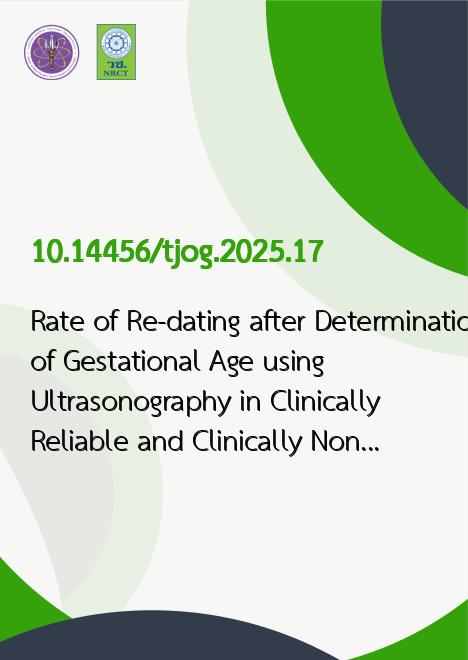
|
Rate of Re-dating after Determination of Gestational Age using Ultrasonography in Clinically Reliable and Clinically Non-reliable Pregnant Women during the First Trimester |
|---|---|
| รหัสดีโอไอ | |
| Creator | Suppada Chattrakoonphong |
| Title | Rate of Re-dating after Determination of Gestational Age using Ultrasonography in Clinically Reliable and Clinically Non-reliable Pregnant Women during the First Trimester |
| Contributor | Kittipong Kongsomboon, Tharangrut Hanprasertpong |
| Publisher | PIMDEE Co., Ltd. |
| Publication Year | 2568 |
| Journal Title | Thai Journal of Obstetrics and Gynaecology |
| Journal Vol. | 33 |
| Journal No. | 2 |
| Page no. | 161-170 |
| Keyword | gestational age, corrected, ultrasonographic, indicated, non-indicated |
| URL Website | https://tci-thaijo.org/index.php/tjog/index |
| Website title | www.tci-thaijo.org |
| ISSN | 2673-0871 |
| Abstract | Objectives: The primary outcome was to compare the rate of gestational age (GA) re-dating after determination of GA using ultrasonography (US) in clinically reliable (non-indicated US) and clinically non-reliable (indicated US) pregnant women during the first trimester. The secondary objective was to present the incidence of accidentally diagnosed abnormal pregnancy and identify the clinical factors influencing the need for GA re-dating.Materials and Methods: This is an analytic cross-sectional study comparing the rate of GA re-dating after determination of GA using US in clinically reliable and clinically non-reliable pregnant women, as well as presenting the incidence of GA re-dating among pregnant women overall and incidence of accidentally diagnosed abnormal pregnancy, comparing the discrepancy in duration of pregnancy between clinically reliable and clinically non-reliable groups. Results: A total of 119 participants were enrolled. After US, 11 (11/119, 9.24%) participants received an abnormal or complicated pregnancy diagnosis. The rate of participants who needed GA re-dating and had an abnormal pregnancy diagnosis in the clinically non-reliable and clinically reliable groups were similar. 23 in 51 (45.1%) participants in clinically non-reliable were needed GA re-dating and 25 in 57 (52.1%) participants in clinically reliable were needed GA re-dating, (p = 0.995). If GA re-dating was needed, there was no statistically significant difference in the median number of days of GA re-dating between the clinically non-reliable and clinically reliable groups [10 (interquartile range (IQR) 07.00-21.00) vs 12 (IQR 8.00-15.00) days, p = 0.872).Conclusion: Nearly half of the pregnant women needed GA re-dating when undergoing US in the first trimester of pregnancy. The rate of GA re-dating was similar in the clinically reliable and clinically non-reliable groups without any hint of clinical factor influence. Approximately 10% of participants found an abnormal pregnancy diagnosis. Eight percent found abnormal pregnancy in clinically reliable groups. |
